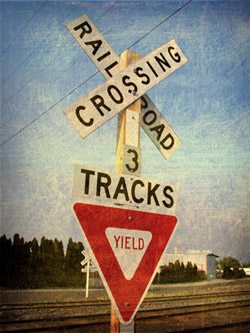|
Do's and Don'ts of Railroad Crossings
More than 3,000 highway-rail grade crossing incidents occur each year. Of those, 700 involve trucks or tractor-trailers, according to the Federal Motor Carrier Safety Administration (FMCSA). These incidents often result in injury and sometimes even death. Your drivers need to be aware of the specific actions required to safely cross railroad tracks in order to prevent collisions and stay in compliance with federal, state and local regulations.
 Part 392.10 of FMCSA’s Rules and Regulations outlines what types of commercial vehicles are required to fully stop at every railroad crossing regardless of whether or not there is a train approaching. These vehicles must stop within 50 feet of, and not closer than 15 feet to, the tracks. Upon confirming there is no train approaching, the driver may proceed across the tracks. Every commercial vehicle that is not listed in Part 392.10 must slow down to a speed permitting it to stop when approaching a highway-rail grade crossing but is not required to come to a full stop unless a train is approaching.
Not following these regulations will result in a driver’s commercial driver’s license (CDL) being disqualified immediately. For the first conviction, the driver will be disqualified for no less than 60 days. A second conviction will result in disqualification for no less than 120 days. And for third or subsequent convictions, the driver will be disqualified for no less than one year. Refer to Table 3 in FMCSA’s Rules and Regulations Part 383.51 for a complete list of actions that can result following a conviction.
Educate your drivers on the following do’s and don’ts of highway-rail grade crossings:
- DO look out for warning signs indicating a crossing is ahead
- Advance warning sign: Round, black and yellow warning sign placed ahead of a public railroad-highway crossing. Upon seeing this warning sign, drivers should slow down, look and listen for a train, and be prepared to stop if a train is approaching.
- Pavement marking: An “X” with the letters “RR” and a no-passing marking on two-lane roads. This marking means the same as the advance warning sign.
- Cross buck sign with or without flashing lights: Located at the grade crossing. Drivers are required to yield to approaching trains. The number on cross buck signs indicates how many tracks there are.
- Flashing lights and gates: Indicate a train is approaching when the lights are flashing and the gate is down. Drivers must stop and remain stopped until the lights are no longer flashing and the gate has risen.
- DO slow down when approaching crossings. Slowing down increases the time drivers have to look for a train and come to a full stop if needed.
- DON’T use cell phones while driving. The Department of Transportation (DOT) has banned interstate and many intrastate truck drivers from using hand-held phones. They are the top distraction for drivers and could prevent them from noticing a train in time to stop.
- DON’T expect to hear a train’s horn. Due to the noise inside trucks, drivers may not be able to hear the horn until the train is right at the crossing. Some small towns have banned train whistles so drivers cannot rely on just listening for them.
- DON’T attempt to race a train to the crossing. It is very difficult to accurately judge the speed of an oncoming train. The average freight train traveling 55 mph covers more than 80 feet per second and takes a mile or more to stop. By the time a train conductor spots a vehicle, it is likely too late for the train to stop. And, because a tractor trailer can take more than 10 seconds to cross a track from a dead stop, a train that is more than eight football field lengths from the vehicle will collide with it before it can safely clear.
- DON’T rely solely on warning signs and devices, which can malfunction or may not be present at every crossing. Drivers should always expect a train, even if it is not time for a regularly scheduled train.
- DO remember that double tracks require a double check. A train on one track may hide a train on another track. Drivers should look both ways and wait until the train has fully cleared the crossing before proceeding.
- DO make sure trailer jacks are in the up position. Non-retracted trailer jacks can cause trucks to become stuck on crossings.
- DON’T shift gears while crossing tracks.
- DO leave the tractor trailer immediately if it stalls or becomes stuck on the track, even if there isn’t a train approaching. If a train is approaching, drivers should run toward the direction from which the train is coming, but at an angle away from the tracks. This will help prevent drivers from being struck by flying debris.
- DO call 911 immediately and report the location of a vehicle that is stuck on the tracks if a train is not immediately seen or heard. An emergency phone number is posted on every electrical box or warning sign that dials directly to the railroad. Be prepared to provide the location number found on the sign.
Make your safety training more effective by using the FMCSA’s railroad crossing safety video and the videos, training guides and other resources available from Operation Lifesaver, Inc., a non-profit, international roadway-railroad crossing safety organization.
Baldwin & Lyons is offering free copies of the Highway-Rail Grade Crossings: 7 Steps for Safety handout card while supplies last.
To order copies of these cards, contact the Loss Prevention Resource Library at 317-636-9800 or email your request to thequill@baldwinandlyons.com. The Resource Library also offers several video training programs to keep drivers safe when crossing railroad tracks.
<< back |
|
